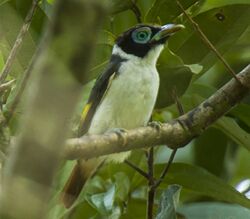Biology:Wattled broadbill
| Wattled broadbill | |
|---|---|

| |
| Scientific classification | |
| Domain: | Eukaryota |
| Kingdom: | Animalia |
| Phylum: | Chordata |
| Class: | Aves |
| Order: | Passeriformes |
| Family: | Eurylaimidae |
| Genus: | Sarcophanops |
| Species: | S. steerii
|
| Binomial name | |
| Sarcophanops steerii (Sharpe, 1876)
| |
| Synonyms | |
|
Eurylaimus steerii | |
The wattled broadbill or Mindanao broadbill (Sarcophanops steerii) is a species of bird in the family Eurylaimidae where it was previously conspecific to the Visayan broadbill. It It is endemic to the islands of Mindanao, Basilan, Dinagat and Siargao in the Philippines. It is one of the most striking birds in the country with its sky-blue wattle and bill and yellow wing patch. Its natural habitats are tropical moist lowland forest, tropical mangrove forest, and tropical moist shrubland. It is threatened by habitat loss.
Description and taxonomy
They are sexually dimorphic in which the males have reddish-pink bellies with the females having clean white bellies.
It is differentiated from the Visayan broadbill with its white collar and bright yellow patch. It is also larger with sizes of 16–18 cm versus the 14–15 cm of the Visayan broadbill.[2]
Subspecies
Two subspecies are recognized:
- Sarcophanops steerii steerii: Central and Eastern Mindanao, Siargao and Dinagat Islands; Larger and darker red on males; No recent records on Dinagat Islands
- Sarcophanops steerii mayri: Zamboanga Peninsula and Basilan; Smaller and paler red on the males; Possibly extinct on Basilan[2]
Habitat and conservation status
Its natural habitats are tropical moist lowland primary forest and well developed secondary forest up to 750 meters above sea level. It appears to not be able to tolerate great amounts of forest degradation. It is known to forage in the lower levels of the forest in the understory and close to the forest floor.
IUCN has assessed this bird as vulnerable with the population being estimated at 2,500 to 9,999. Extensive lowland deforestation on all islands in its range is the main threat. Most remaining lowland forest that is not afforded protection leaving it vulnerable to both legal and Illegal logging, conversion into farmlands through Slash-and-burn and mining.
This occurs in a few protected areas such as Mt. Apo, Pasonanca Natural Park and Siargao Island Protected Landscape however protection is lax.
Conservation actions proposed include to survey remaining habitat to establish its current distribution, population status and ecology.[3]
References
- ↑ BirdLife International (2017). "Sarcophanops steerii". IUCN Red List of Threatened Species 2017: e.T22698738A117597507. doi:10.2305/IUCN.UK.2017-3.RLTS.T22698738A117597507.en. https://www.iucnredlist.org/species/22698738/117597507. Retrieved 12 November 2021.
- ↑ 2.0 2.1 Allen, Desmond (2020). Birds of the Philippines. Barcelona: Lynx and Birdlife Guides International. pp. 234–235.
- ↑ International), BirdLife International (BirdLife (2017-10-01). "IUCN Red List of Threatened Species: Sarcophanops steerii". https://www.iucnredlist.org/en.
External links
Wikidata ☰ Q27075050 entry
 |


